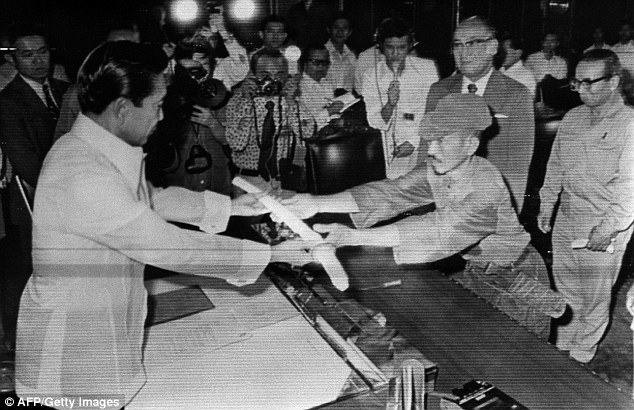Tvälups
Ylipäällikkö
yle 1.1.2014 klo 9:18
Japanin pääministeri haluaa purkaa asevoimilta historialliset rajoitukset
Tokion vuoden 2020 olypialaiset ovat Shinzo Aben mielestä sopiva takaraja sille, että Japanin asevoimat saisi oikeuden myös hyökätä vain puolustautumisen sijaan.
Japanin pääministeri Shinzo Abe haluaa maansa muuttavan vielä tällä vuosikymmenellä perustuslakiaan, joka nykyisin sanelee, että Japanin asevoimia voidaan käyttää vain oman valtion puolustamiseen.
Toisen maailmansodan häviäjävaltiona Japanin oli Yhdysvaltain vaatimuksesta poistettava perustuslaistaan oikeus hyökkäyksiin. Aben mielestä lakia on muutettava ennen vuotta 2020, jolloin Tokio isännöi kesäolympialaisia.
– Laki tuli voimaan 68 vuotta sitten. Tarvitsemme kunnollista kansallista keskustelua, jotta laki seuraisi aikamme muutoksia, Abe sanoi uudenvuodenhaastattelussaan Sankei Shimbun -lehdessä.
Hän perustelee, että vuoteen 2020 mennessä Japani on viimeistään saanut takaisin statuksensa annettuaan isoja panoksia rauhan ja vakauden suojelemiselle Aasiassa ja muualla maailmassa. Hän sanoo myös olevansa varma, että laki saadaan uusittua hänen kaavailemassaan ajassa.
Sotamuistomerkki hiertää jälleen
Aben aikomus tehdä Japanin hyvin varustetuista puolustusvoimista täysimittaiset asevoimat herättää huolta Aasian maissa, joissa Japanin 1900-luvun miehityssodat ovat hyvin muistissa.
Uutenavuonna muistoja on tuonut jälleen pintaan Japanin sisäministerin Yoshitaka Shindon vierailu kiistellyllä Yasukunin sotamuistomerkillä, jolla myös Abe kävi jouluviikolla.
Vierailu herätti paljon pahaa vertaa naapurimaissa, ja myös monet muut pahoittelivat sitä. YK:n pääsihteeri Ban Ki-moon sanoi, että jännitteiden vuoksi osapuolten olisi erittäin suotavaa ottaa huomioon toistensa tunteet.
Lehtihaastattelussa asiaa kysyttäessä Saksan liittokansleri Angela Merkel kehotti Japania katsomaan rehellisesti silmiin menneisyyden tekojaan. Vain siten syntyy pohja uusille suhteille entisiin vihollisiin, Merkel sanoi oman maansa kokemuksiin viitaten.
Yasukunin muistomerkki on omistettu kaikille sodissa kuolleille japanilaisille, myös niille upseereille, jotka teloitettiin sotarikollisina toisen maailmansodan jälkeen. Kiinalle ja Etelä-Korealle se on tyly muistutus Japanin imperialistisesta menneisyydestä ja kyvyttömyydestä katua. Aben mukaan käynti muistomerkillä oli yksityinen.
Lähteet:
AFP, Reuters
Japanin pääministeri haluaa purkaa asevoimilta historialliset rajoitukset
Tokion vuoden 2020 olypialaiset ovat Shinzo Aben mielestä sopiva takaraja sille, että Japanin asevoimat saisi oikeuden myös hyökätä vain puolustautumisen sijaan.
Japanin pääministeri Shinzo Abe haluaa maansa muuttavan vielä tällä vuosikymmenellä perustuslakiaan, joka nykyisin sanelee, että Japanin asevoimia voidaan käyttää vain oman valtion puolustamiseen.
Toisen maailmansodan häviäjävaltiona Japanin oli Yhdysvaltain vaatimuksesta poistettava perustuslaistaan oikeus hyökkäyksiin. Aben mielestä lakia on muutettava ennen vuotta 2020, jolloin Tokio isännöi kesäolympialaisia.
– Laki tuli voimaan 68 vuotta sitten. Tarvitsemme kunnollista kansallista keskustelua, jotta laki seuraisi aikamme muutoksia, Abe sanoi uudenvuodenhaastattelussaan Sankei Shimbun -lehdessä.
Hän perustelee, että vuoteen 2020 mennessä Japani on viimeistään saanut takaisin statuksensa annettuaan isoja panoksia rauhan ja vakauden suojelemiselle Aasiassa ja muualla maailmassa. Hän sanoo myös olevansa varma, että laki saadaan uusittua hänen kaavailemassaan ajassa.
Sotamuistomerkki hiertää jälleen
Aben aikomus tehdä Japanin hyvin varustetuista puolustusvoimista täysimittaiset asevoimat herättää huolta Aasian maissa, joissa Japanin 1900-luvun miehityssodat ovat hyvin muistissa.
Uutenavuonna muistoja on tuonut jälleen pintaan Japanin sisäministerin Yoshitaka Shindon vierailu kiistellyllä Yasukunin sotamuistomerkillä, jolla myös Abe kävi jouluviikolla.
Vierailu herätti paljon pahaa vertaa naapurimaissa, ja myös monet muut pahoittelivat sitä. YK:n pääsihteeri Ban Ki-moon sanoi, että jännitteiden vuoksi osapuolten olisi erittäin suotavaa ottaa huomioon toistensa tunteet.
Lehtihaastattelussa asiaa kysyttäessä Saksan liittokansleri Angela Merkel kehotti Japania katsomaan rehellisesti silmiin menneisyyden tekojaan. Vain siten syntyy pohja uusille suhteille entisiin vihollisiin, Merkel sanoi oman maansa kokemuksiin viitaten.
Yasukunin muistomerkki on omistettu kaikille sodissa kuolleille japanilaisille, myös niille upseereille, jotka teloitettiin sotarikollisina toisen maailmansodan jälkeen. Kiinalle ja Etelä-Korealle se on tyly muistutus Japanin imperialistisesta menneisyydestä ja kyvyttömyydestä katua. Aben mukaan käynti muistomerkillä oli yksityinen.
Lähteet:
AFP, Reuters












